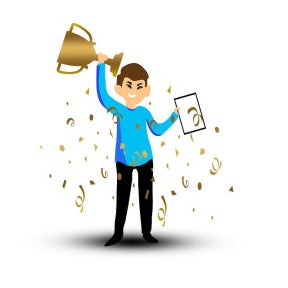How to Design a Reward and Recognition Program:
A step-by-step guide to creating an effective employee reward and recognition program.
Take a holistic approach.
Start by understanding the different types of employee recognition.

Before a recognition program can be implemented, employers need to understand the key types of employee recognition. These are:
- Public recognition: for example, a shout-out about an employee's achievement on social media, in-office announcements, a newsletter feature, etc.
- Private recognition: for example, a thank you note or email from a manager or the CEO.
- Promotion: for example, increased responsibilities or an entirely new role.
- Monetary: for example, gift cards, paid vacations, a raise, merchandise, etc.
Ask for feedback.

Ask your employees to fill out an Employee Satisfaction Survey to help you gauge how happy and appreciated they currently feel at work. Based on their feedback, incorporate their wants and needs into your employee recognition program.
Determine the criteria for rewarding employees.

Think about what type of skills, behaviors, and outcomes would warrant an award and whether these align with your company culture, mission, values, and goals.
It is important to consider the main characteristics of effective employee recognition programs:
- Timely — rewards should be given as soon as possible after the achievement to reinforce positive behavior.
- Frequent — celebrate both small and large achievements often to keep employees engaged and motivated.
- Specific — acknowledging why the employee's contribution is being rewarded makes it sincere.
- Visible — publically recognizing someone can be an example to other employees and facilitate collaboration among team members.
- Inclusive — inclusive recognition promotes equity in the organization.
- Values-based — recognition based on values encourages the team to work toward the same goal.
Decide how you will reward employees.

Depending on the number of employees in your organization and your budget, you'll want to decide on the type of rewards you will provide. But what if you're a small business with limited resources?
Reports say that money is no longer the best motivator for employees. While money is great in certain situations, employees prefer to know how they have contributed to the success of the organization and to be recognized for these contributions.
A simple "thank you" or praise for good work can be just as powerful as a gift card or other monetary reward, but keep in mind that different people are motivated in different ways, so make sure that you offer a variety of incentives and that these are commensurate with the employee's performance to avoid causing friction within the team.
Educate your employees about the program.

For the employee reward and recognition program to be a success, employees need to understand how it works and what they need to do to earn recognition. To achieve this, enlist the help of management and key employees to promote and execute the program.
Evaluate the program.

Once the program has been implemented, it's important to review and evaluate it regularly to discern how effective it is. Consider whether the rewards are adequate and fair, whether your employees are happy with them, and if the program has contributed to improved processes in your organization.


